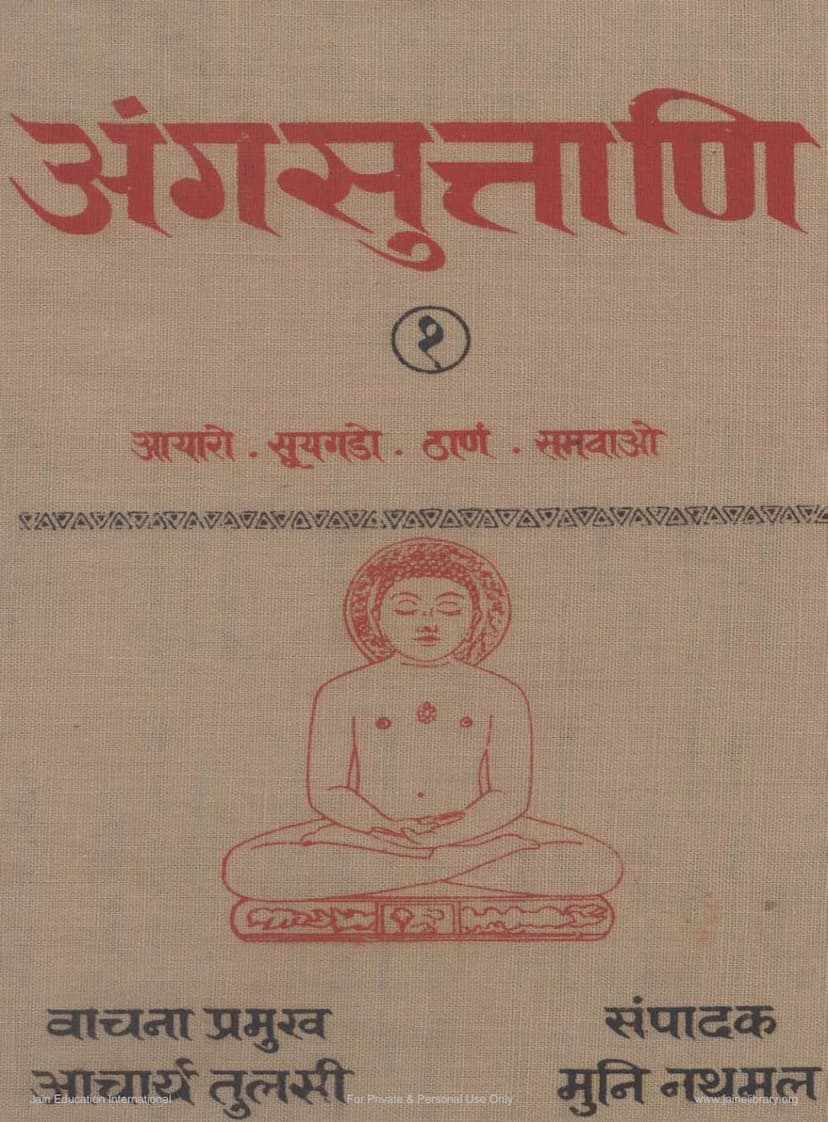Agam 04 Ang 04 Samvayang Sutra Samvao Terapanth
Added to library: September 1, 2025

Summary
Here's a comprehensive summary of the Jain text "Agam 04 Ang 04 Samvayang Sutra Samvao Terapanth," critically edited by Acharya Tulsi and edited by Muni Nathmal, published by Jain Vishva Bharati:
Book Overview:
This publication is part of a larger project by Jain Vishva Bharati to critically edit and publish the Jain Agamas. This specific volume, Agam 04 Ang 04 Samvayang Sutra Samvao Terapanth, focuses on the Samavāyānga Sūtra, which is the fourth Anga (part) of the Dwadasangi (Twelve Limbs of Jain scripture). The text is presented in its original Prakrit language and has been meticulously edited.
Key Aspects and Content:
- Context and Dedication: The book is dedicated to the 25th Nirvana anniversary of Lord Mahavir, reflecting a desire to bring his teachings to the public on this significant occasion. The preface expresses Acharya Tulsi's deep satisfaction in seeing the lifelong vision of a research-based editing of the Agamas come to fruition. Muni Nathmal, the editor, elaborates on the extensive effort and collaboration involved.
- Editorial Philosophy: The editors emphasize a rigorous approach to text correction, relying on a comparative study of multiple ancient manuscripts (Ādarśas) and commentaries (Ćūrņi and Vritti). They acknowledge the complexities of textual variations and the challenges of textual preservation over centuries due to factors like forgetfulness, script changes, the assimilation of commentary into the main text, and the intervention of time and place. They also highlight the tradition of abridging texts for memorization and the efforts made to restore these abridged passages where possible.
- The Samavāyānga Sūtra:
- Name and Meaning: The name "Samavāyānga" is derived from the concept of "Samavātāra" or "Samavāsa," meaning the classification, arrangement, or confluence of substances like Jiva (soul), Ajiva (non-soul), Loka (universe), Aloka (non-universe), and Swa-samaya (one's own doctrine) versus Para-samaya (other doctrines). The Digambara tradition also interprets it as the decision of Jiva and other substances based on similarity and generality.
- Subject Matter: The Samavāyānga is a compendium that systematically enumerates and categorizes various Jain philosophical concepts. Its subject matter includes:
- The classification of Jiva, Ajiva, Loka, and Aloka.
- The enumeration of various entities and phenomena, often presented in numerical sequences (e.g., numbers from one to hundred).
- A detailed description of the Dwadasangi (Twelve Angas) itself, thus being a meta-text within the Angas.
- The text delves into specific classifications of elements like souls, bodies, senses, passions, abodes, lifespan, deities, celestial bodies (planets, stars), geographical features (continents, mountains, oceans), temporal units, and various classifications of actions and states.
- Structure and Content Details: The book provides detailed lists and descriptions of the contents of each "Samavāya" (chapter or section) within the larger Samavāyānga Sūtra. These sections cover a vast array of topics, including:
- Cosmology and Geography: Descriptions of the universe, continents (like Jambudvipa), various hells (Naraka), heavens (Vimana), mountains, oceans, and their measurements.
- Chronology and Time: Cycles of time, lifespans of beings, durations of celestial bodies, and time divisions.
- Buddhology and Jinaology: Lists of Tirthankaras (spiritual teachers), Chakravartis (universal monarchs), Baladevas, Vasudevas, and the lineage of spiritual leaders (Ganas, Ganadharas).
- The Twelve Angas: A description of each of the twelve Angas, reiterating their names and sometimes their content.
- Numerical Classifications: A significant portion of the Samavāyānga is dedicated to enumerating things based on numbers, such as the twenty-five Bhavanas, thirty-three Samitis, forty-four Gatis, fifty-six types of states, seventy-two types of conduct, and so on.
- Classification of Souls and Bodies: Discusses different types of souls and their classifications based on senses, consciousness, and karmic dispositions.
- Karma and Conduct: Details aspects of Jain ethics, including vows (Mahavratas), austerities (Tapas), and the classification of karmas.
- Editorial Process and Contributors: The publication acknowledges the significant contribution of various individuals and institutions. It mentions:
- Vaćana Pramukha (Chief Exponent): Ācārya Tulsi.
- Sampadak (Editor): Muni Nathmal.
- Prabandh Sampadak (Managing Editor): Shreechand Rampuria.
- Financial Assistance: Sri Ramlal Hansraj Golchha.
- Printers: S. Narayan & Sons.
- Collaborators: Muni Dulahraj, Muni Sudarshan, Muni Madhukar, Muni Hiralal, and Muni Shubh-karan (for content refinement). Muni Dulahraj is specifically mentioned for "Prati-shodhan" (manuscript correction).
- Acknowledged Support: The work also benefited from the support of the Saravagi Charitable Fund, Calcutta, and the Ideal Sahitya Sangh.
- Manuscript Introduction (Prati Parichay): The book includes a section detailing the various manuscripts used for the critical edition, providing information about their source, number of pages, dimensions, script, and dating (where available). This demonstrates the scholarly effort behind establishing the authentic text.
- Emphasis on Jain Principles: The underlying philosophy of Jainism, such as the importance of conduct (Ācāra), non-violence, self-control, detachment, and spiritual discipline, is woven throughout the Agamic teachings presented.
In essence, this volume provides a scholarly, critically edited version of the Samavāyānga Sūtra, offering an invaluable resource for understanding the systematic classification and enumeration of Jain doctrines and cosmological details, presented within the framework of the sacred Agamas.